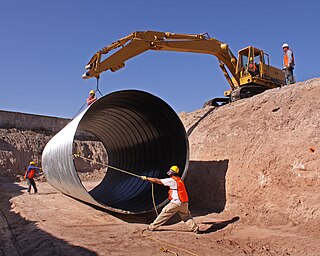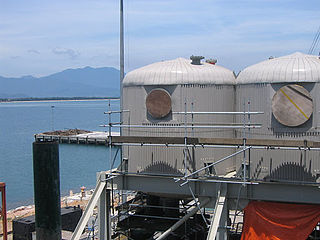The Occupational Safety and Health Administration is a regulatory agency of the United States Department of Labor that originally had federal visitorial powers to inspect and examine workplaces. The United States Congress established the agency under the Occupational Safety and Health Act, which President Richard M. Nixon signed into law on December 29, 1970. OSHA's mission is to "assure safe and healthy working conditions for working men and women by setting and enforcing standards and by providing training, outreach, education, and assistance." The agency is also charged with enforcing a variety of whistleblower statutes and regulations. OSHA's workplace safety inspections have been shown to reduce injury rates and injury costs without adverse effects on employment, sales, credit ratings, or firm survival.

Workers' compensation or workers' comp is a form of insurance providing wage replacement and medical benefits to employees injured in the course of employment in exchange for mandatory relinquishment of the employee's right to sue his or her employer for the tort of negligence. The trade-off between assured, limited coverage and lack of recourse outside the worker compensation system is known as "the compensation bargain.” One of the problems that the compensation bargain solved is the problem of employers becoming insolvent as a result of high damage awards. The system of collective liability was created to prevent that and thus to ensure security of compensation to the workers.

A safety data sheet (SDS), material safety data sheet (MSDS), or product safety data sheet (PSDS) is a document that lists information relating to occupational safety and health for the use of various substances and products. SDSs are a widely used system for cataloguing information on chemicals, chemical compounds,chemical mixtures. SDS information may include instructions for the safe use and potential hazards associated with a particular material or product, along with spill-handling procedures. The older MSDS formats could vary from source to source within a country depending on national requirements; however, the newer SDS format is internationally standardized.

The Occupational Safety and Health Act of 1970 is a US labor law governing the federal law of occupational health and safety in the private sector and federal government in the United States. It was enacted by Congress in 1970 and was signed by President Richard Nixon on December 29, 1970. Its main goal is to ensure that employers provide employees with an environment free from recognized hazards, such as exposure to toxic chemicals, excessive noise levels, mechanical dangers, heat or cold stress, or unsanitary conditions. The Act created the Occupational Safety and Health Administration (OSHA) and the National Institute for Occupational Safety and Health (NIOSH).
Occupational noise is the amount of acoustic energy received by an employee's auditory system when they are working in the industry. Occupational noise, or industrial noise, is often a term used in occupational safety and health, as sustained exposure can cause permanent hearing damage. Occupational noise is considered an occupational hazard traditionally linked to loud industries such as ship-building, mining, railroad work, welding, and construction, but can be present in any workplace where hazardous noise is present.

Dangerous goods, abbreviated DG, are substances that when transported are a risk to health, safety, property or the environment. Certain dangerous goods that pose risks even when not being transported are known as hazardous materials. An example for dangerous goods is hazardous waste which is waste that has substantial or potential threats to public health or the environment.

Lock out, tag out or lockout–tagout (LOTO) is a safety procedure used to ensure that dangerous equipment is properly shut off and not able to be started up again prior to the completion of maintenance or repair work. It requires that hazardous energy sources be "isolated and rendered inoperative" before work is started on the equipment in question. The isolated power sources are then locked and a tag is placed on the lock identifying the worker and reason the LOTO is placed on it. The worker then holds the key for the lock, ensuring that only they can remove the lock and start the equipment. This prevents accidental startup of equipment while it is in a hazardous state or while a worker is in direct contact with it.

The Control of Substances Hazardous to Health Regulations 2002 is a United Kingdom Statutory Instrument which states general requirements imposed on employers to protect employees and other persons from the hazards of substances used at work by risk assessment, control of exposure, health surveillance and incident planning. There are also duties on employees to take care of their own exposure to hazardous substances and prohibitions on the import of certain substances into the European Economic Area. The regulations reenacted, with amendments, the Control of Substances Hazardous to Work Regulations 1999 and implement several European Union directives.
An environmental health officer (EHO), also referred to as an environmental health practitioner (EHP) or public health inspector, is a person responsible for carrying out measures to protect public health, which includes the administration and enforcement of legislation related to environmental health and safety hazards.
The WorkCover Authority of New South Wales was a New South Wales Government agency established in 1989. The agency created regulations to promote productive, healthy and safe workplaces for workers and employers in New South Wales. The agency formed part of the Safety, Return to Work and Support Division established pursuant to the Safety, Return to Work and Support Board Act, 2012 (NSW).
A safety management system (SMS) is designed to manage safety risk in the workplace, occupational safety being defined as the reduction of risk to a level that is as low as is reasonably practicable (ALARP) to prevent people getting hurt.
Prevention through design (PtD), also called safety by design usually in Europe, is the concept of applying methods to minimize occupational hazards early in the design process, with an emphasis on optimizing employee health and safety throughout the life cycle of materials and processes. It is a concept and movement that encourages construction or product designers to "design out" health and safety risks during design development. The process also encourages the various stakeholders within a construction project to be collaborative and share the responsibilities of workers' safety evenly. The concept supports the view that along with quality, programme and cost; safety is determined during the design stage. It increases the cost-effectiveness of enhancements to occupational safety and health.
A lone worker (LW) is an employee who performs an activity that is carried out in isolation from other workers without close or direct supervision. Such staff may be exposed to risk because there is no-one to assist them and so a risk assessment may be required. Lone workers are now often supported by cloud-based automated monitoring systems and specialised monitoring call centres - often referred to as an 'Alarm Receiving Centre' or 'ARC' in the UK, or 'Emergency Dispatch Center' or 'EDC' in the US.
The Australian Dangerous Goods Code is promulgated by The Advisory Committee on Transport of Dangerous Goods. The most current version is the seventh edition, 7.7 released in 2020 and mandated from October 1 2021. Read in conjunction with accompanying national and State laws, the document creates a significant level of standardisation for the transportation of dangerous goods in Australia.

The Occupational Health and Safety Act 2000 is a repealed statute of New South Wales (NSW). The Act was repealed by the Work Health and Safety Act 2011.

The AS/NZS 1200 standard is a joint Australian/New Zealand Standard, for the requirements of pressure equipment which aims to promote safety and uniformity throughout Australia and New Zealand.

Occupational safety and health (OSH) or occupational health and safety (OHS), also known simply as occupational health or occupational safety, is a multidisciplinary field concerned with the safety, health, and welfare of people at work. These terms also refer to the goals of this field, so their use in the sense of this article was originally an abbreviation of occupational safety and health program/department etc. OSH is related to the fields of occupational medicine and occupational hygiene.
The Occupational Health and Safety (OHS) Regulation of British Columbia is the primary source of law governing workplace health and safety, which was most recently amended in 2016. It sets the standard to which workplaces must attain when inspected by WorkSafeBC, unless they are exempt from inspection, e.g. mines.
The law for workplace bullying is given below for each country in detail. Further European countries with concrete antibullying legislation are Belgium, France, and The Netherlands.
Chemical safety includes all those policies, procedures and practices designed to minimize the risk of exposure to potentially hazardous chemicals. This includes the risks of exposure to persons handling the chemicals, to the surrounding environment, and to the communities and ecosystems within that environment. Manufactured chemicals, either pure or in mixtures, solutions and emulsions, are ubiquitous in modern society, at industrial, occupational and private scale. However, there are chemicals that should not mix or get in contact with others, as they can produce byproducts that may be toxic, carcinogenic, explosive etc., or can be dangerous in themselves. To avoid disasters and mishaps, maintaining safety is paramount.








